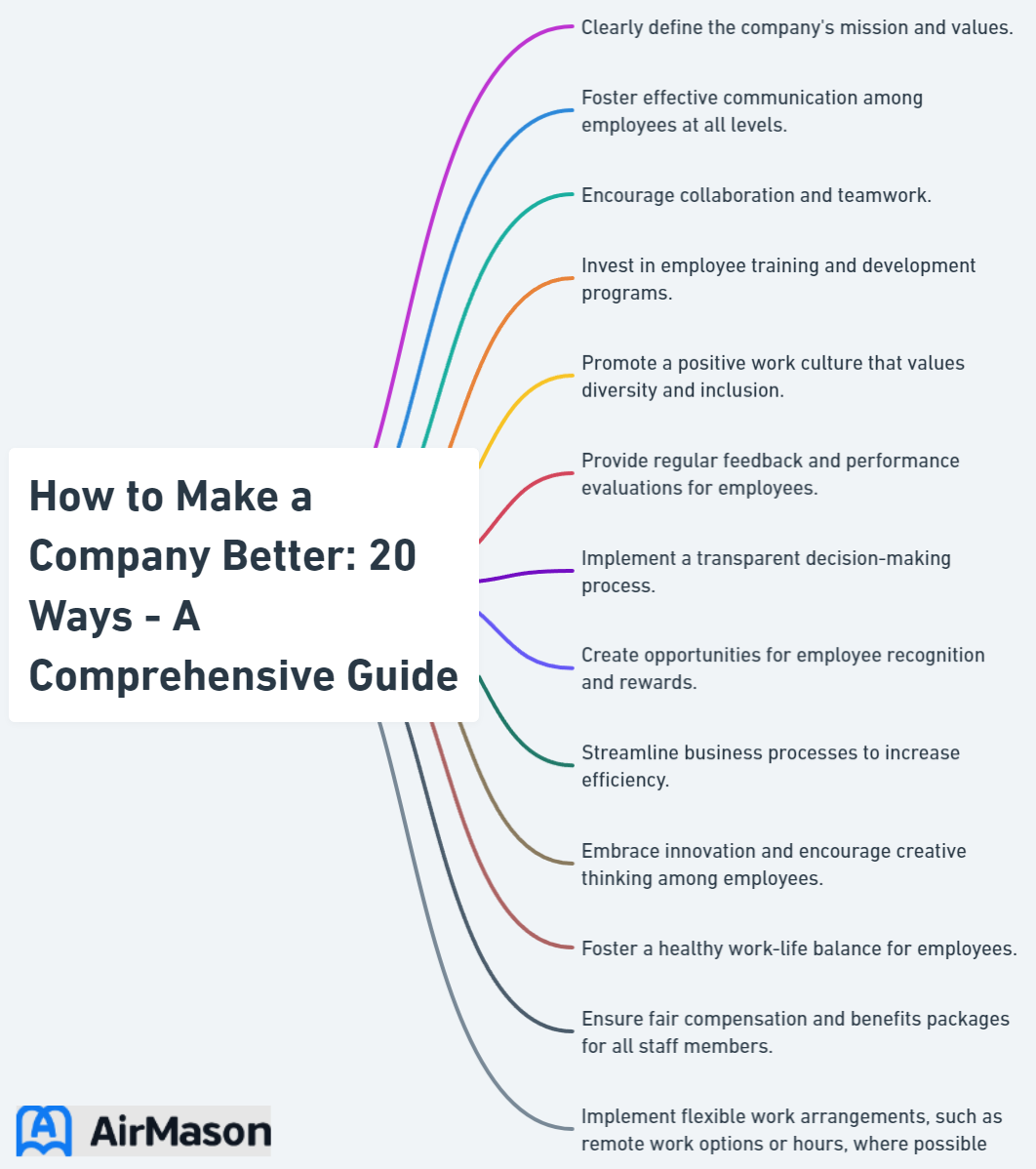
In today’s competitive business landscape, creating a thriving company culture is essential for success. But how can you ensure your company is a place where employees feel valued, engaged, and inspired to perform at their best? The answer lies in implementing a comprehensive approach that encompasses various strategies, from prioritizing mental health to fostering innovation. In this blog post, we will explore these strategies and provide you with a roadmap on how to make a company better, transforming your company culture and achieving remarkable results.
Key Takeaways
- Foster a positive workplace environment by prioritizing mental health, providing comfortable workspaces and implementing work-life balance initiatives.
- Build strong coworker relationships through team building activities, mentorship programs and inclusive social events.
- Align business strategy with organizational values to recognize employee contributions, embrace diversity & inclusivity, encourage innovation & strengthen leadership skills.
Understanding the Importance of Company Culture
Company culture is the backbone of any successful organization. It reflects the company’s values, mission, and goals, shaping the work environment and influencing employee engagement, productivity, and overall business success. Creating a great workplace environment is not just a matter of aesthetics; it has a direct impact on:
- Employee morale
- Motivation
- Psychological well-being
- Productivity
Cultivating a thriving organizational culture that breeds highly engaged, happy employees requires alignment of company values with employees’ needs. By focusing on the well-being of your staff members and establishing a positive working environment, you can attract the best employees, retain valuable employees, and promote a sense of belonging and commitment to the company’s mission and values.

Enhancing Employee Engagement
The success of any company hinges on employee engagement. Engaged employees are more motivated, productive, and committed to the organization. Three key strategies instrumental in enhancing employee engagement include encouraging open communication, providing regular feedback, and offering professional development opportunities.
Open communication fosters trust, collaboration, and accountability, while regular feedback helps employees understand their strengths and areas for improvement, leading to better performance and job satisfaction. Professional development opportunities support personal growth and keep employees engaged in their roles, ultimately contributing to a better workplace.
Encourage Open Communication
Open communication is the cornerstone of a healthy work environment. When employees feel comfortable expressing their thoughts and ideas, they are more likely to trust their colleagues and collaborate effectively with other employees. Research shows that highly engaged employees are 17% more productive than their colleagues, and effective communication with employees can potentially increase their productivity by 20-25%.
To promote open communication, create a supportive work environment that encourages employees to speak up and share their opinions. Offer regular feedback and motivate employees to express their ideas and concerns. Additionally, managers should be receptive to employees and address their queries promptly.
Provide Regular Feedback
Providing regular and balanced feedback is essential for helping employees tailor their performance to the organizational culture. Feedback should be supplied at least once a week, depending on the employment situation and relationship, and it should be provided promptly after the moment has transpired to ensure its efficacy.
Regular feedback enables employees to gain a better understanding of their strengths and areas for improvement, leading to improved performance and increased job satisfaction. By creating a culture of constructive feedback, you can foster a more engaged and motivated workforce that contributes to the company’s overall success.
Offer Professional Development Opportunities
Offering professional development opportunities is vital for employee growth and engagement. By investing in the development of your employees, you can improve their skills, advance their careers, and build confidence, ultimately leading to higher engagement levels and better performance.
To create effective professional development opportunities, consider offering a variety of options tailored to the needs of your employees. Here are some strategies to consider:
- Establish clear objectives for the professional development programs.
- Evaluate the intensity and duration of the programs to ensure they align with the goals and availability of your employees.
- Incorporate collaboration opportunities, such as group projects or team-based learning, to encourage knowledge sharing and networking.
- Offer financial support, such as reimbursement for course fees or funding for certifications, to remove barriers to participation. By implementing these strategies, you can support the personal growth of your employees and contribute to the overall success of your organization.
An Organization’s Culture
An organization’s culture is the invisible thread that weaves together its values, beliefs, and practices into a cohesive fabric. It is the collective mindset and behavioral norms that define how members interact, work, and innovate within the entity. This culture permeates every level, influencing decision-making, employee morale, and even the way the organization interfaces with its external environment. A healthy organizational culture fosters an environment where individuals feel motivated, engaged, and aligned with the company’s mission. Conversely, a toxic or misaligned culture can lead to discontentment, high turnover, and diminished productivity. Therefore, nurturing and maintaining a positive organizational culture is imperative for long-term success and sustainability.
Fostering a Positive Workplace Environment

Keeping employees engaged, inspired, and content with their jobs necessitates a positive workplace environment. To foster a positive work environment, companies should prioritize mental health, furnish suitable workspaces, and institute work-life balance initiatives. By doing so, businesses can create a more supportive atmosphere that boosts employee morale and overall productivity.
A positive work environment prioritizes both business success and employee happiness, making it essential for companies to focus on both aspects. By addressing the physical and emotional needs of employees, companies can create a healthy environment, enhance the overall well-being of their workforce, and improve their chances of success.
Prioritize Mental Health
The overall well-being and productivity of employees greatly depend on mental health. Supporting mental health in the workplace can help employees manage stress and maintain a healthy work-life balance. Employers can proactively create a healthier, supportive work environment for their employees. They can do this by implementing employee health and wellness plans to reduce fatigue, illness, and burnout..
There are various resources available to assist employers in supporting mental health in the workplace, such as:
- Workplace mental health campaigns
- Employee assistance programs (EAPs)
- Resources provided by organizations like the Center for Workplace Mental Health and the Department of Labor
By prioritizing mental health, companies can foster an environment of trust and support, resulting in more dedicated and engaged employees.
Create Comfortable Workspaces
Employee productivity and satisfaction are heavily influenced by comfortable workspaces. Creating a comfortable office environment with ergonomic furniture, natural lighting, and a clean atmosphere can augment productivity and employee contentment, as well as diminish stress and enhance morale.
Companies that prioritize employee comfort create an atmosphere that helps employees feel more comfortable and motivated. By investing in the design and maintenance of their workspace, businesses can not only improve employee performance but also create a more advantageous work environment for everyone.
Implement Work-Life Balance Initiatives
Employee well-being and performance are significantly influenced by work-life balance. Implementing work-life balance initiatives, such as flexible work hours and remote work options, can help employees manage their personal responsibilities while staying engaged in their roles.
Flexible work hours provide employees with greater control over their time, enabling them to better manage their personal and professional lives, resulting in decreased stress and improved overall well-being. Remote work options offer employees the freedom to work from any location, granting them the opportunity to work in a comfortable and familiar setting, which can help reduce stress levels and enhance productivity.
Building Strong Coworker Relationships

Employee engagement and company success are deeply tied to strong co workers relationships. By fostering a sense of camaraderie and teamwork among employees, companies can create a more collaborative and supportive work environment. To build strong co workers relationships, organizations should focus on team-building activities, mentorship programs, and inclusive social events.
Team-building activities promote enhanced collaboration, trust, and communication among employees, improving workplace culture. Mentorship programs facilitate knowledge transfer, skill acquisition, and professional advancement, while inclusive social events encourage a sense of belonging and positive interactions among personnel. By investing in these strategies, companies can create a more engaged and motivated workforce that contributes to overall success.
Organize Team-Building Activities
Improved collaboration, trust, and communication among employees can be achieved effectively through team-building activities. By engaging in team-building exercises, employees can break down barriers, forge stronger relationships, and enhance their overall performance. Examples of effective team-building activities for workplaces include Human Knot, Scavenger Hunts, Office Trivia, Escape Room, and Guacamole Challenge.
It is recommended to arrange team-building activities at least a few times a year, with the events varying each time. Regular team-building events can help maintain team morale and create a more cohesive and collaborative work environment, ultimately contributing to the success of the company.
Encourage Mentorship Programs
Both employees and the organization as a whole can reap numerous benefits from mentorship programs. By pairing experienced employees with less experienced colleagues, mentorship programs provide opportunities for knowledge transfer, skill acquisition, and professional advancement.
To ensure the successful implementation of a mentorship program, it is essential to:
- Establish specific objectives
- Select mentors who are respected within the organization
- Pair mentors and mentees based on their goals and preferences
- Provide the necessary training and resources
By following these steps, companies can create a valuable mentorship program that supports employee growth and strengthens coworker relationships.
Promote Inclusive Social Events
Fostering a sense of belonging and positive relationships among employees relies heavily on inclusive social events. By organizing events that promote interaction and collaboration, companies can create an environment where employees feel included and valued.
To ensure inclusivity in company events, consider offering a variety of activities that cater to different interests and preferences. Engage employees in the planning process, and encourage them to share their ideas and suggestions. By promoting inclusive social events, companies can strengthen coworker relationships and create a more engaged and motivated workforce.
Hard Working Culture: The Foundation of Success
A hard working culture forms the bedrock of any thriving organization. It is a collective mindset that permeates through every level, motivating individuals to consistently push their boundaries and strive for excellence. Within such an environment, employees are not merely clock-watchers, but rather dedicated contributors who understand the value of their efforts towards the larger mission. This culture is characterized by an unwavering commitment to the pursuit of goals, often exceeding expectations and driving innovation. It fosters an atmosphere of continuous improvement, where challenges are seen as opportunities to grow rather than obstacles. In a workplace that embraces a hard working culture, each team member takes pride in their contributions, knowing that they play an integral role in the overall success of the organization.
Aligning Business Strategy with Organizational Values

Better decision-making and overall performance are achieved when business strategy is aligned with organizational values, ensuring that employees understand the company’s mission and goals. When employees comprehend the company’s objectives and values, they are more likely to make informed decisions that contribute to the success of the organization.
Successful companies that have effectively aligned their business strategy with their organizational values include:
- Kellogg’s
- Google (Alphabet)
- Apple
- Patagonia
- Unilever
By focusing on aligning business strategy with organizational values, companies can create a more engaged and motivated workforce that contributes to the overall success of the organization.
Recognizing and Rewarding Employee Contributions

Boosting morale, increasing motivation, and retaining top talent are tied to recognizing and rewarding employee contributions. By creating a recognition-rich culture, companies can foster a more engaged and committed workforce. Research demonstrates that businesses with a recognition-rich culture have a significantly lower turnover rate, which positively impacts employee retention. The top 20% of companies leading in this area have a 31% reduced turnover rate compared to other organizations.
To implement effective recognition and rewards programs, companies should focus on providing timely and meaningful feedback, celebrating achievements, and offering a variety of rewards that cater to different employee preferences. By acknowledging and rewarding employee contributions, companies can not only improve employee satisfaction but also contribute to the overall success of the organization.
Embracing Diversity and Inclusivity

Creating a more innovative and dynamic work environment requires embracing diversity and inclusivity. By fostering a diverse and inclusive workplace, companies can tap into the unique perspectives and experiences of their employees, leading to better problem-solving and decision-making.
To promote diversity and inclusivity, companies should implement interventions that reduce discrimination and cognitive bias, and ensure that all employees feel valued and included. By embracing diversity and inclusivity, companies can create a more vibrant and dynamic work environment that contributes to the overall success of the organization.
Encouraging Innovation and Creative Thinking

Staying competitive and adapting to changing market conditions necessitates encouraging innovation and creative thinking. By fostering an environment where employees feel empowered to share their ideas and contribute to the company’s growth, businesses can drive innovation and stay ahead of the competition.
To encourage innovation in the workplace, companies should focus on creating a culture that values creativity, collaboration, and experimentation. Providing employees with the necessary resources, support, and autonomy to explore new ideas and solutions can lead to the development of groundbreaking products and services that propel the company forward.
Strengthening Leadership and Management Skills

Creating a better company culture and inspiring employees to perform at their best are contingent on effective leadership and management skills. Strong leaders can:
- Instill enthusiasm
- Stimulate employees to reach their peak performance
- Foster a positive work environment
- Encourage collaboration and teamwork
- Provide clear direction and guidance
These qualities ultimately contribute to the success of the organization.
To enhance leadership skills, managers should focus on building trust, promoting open communication, and providing support for employee growth and development. By investing in the development of strong leadership and management skills, companies can create a more engaged and motivated workforce that drives the organization toward success.
Fostering Team Culture
Fostering team culture is a critical aspect of building a cohesive and high-performing work environment. It entails creating a shared set of values, goals, and behaviors that unite team members towards a common purpose. This process begins with clear communication of expectations and an emphasis on open and respectful dialogue. Encouraging collaboration and recognizing individual strengths within the team further solidifies this culture. Regular team-building activities and workshops can play a pivotal role in strengthening connections and nurturing a sense of belonging among team members. Ultimately, a well-cultivated team culture not only boosts morale and productivity but also lays the foundation for long-term success and innovation within the organization.
Implementing Effective Performance Assessments

Identifying areas for improvement, setting clear expectations, and providing employees with the necessary support and resources to succeed hinge on effective performance assessments. By implementing regular performance assessments, companies can ensure that employees are aware of their strengths and areas for development, ultimately leading to better performance and job satisfaction.
To implement effective performance assessments, companies should focus on setting clear objectives, maintaining open communication, and providing regular feedback. By conducting thorough and fair performance evaluations, companies can support employee growth and ensure that their workforce is equipped to contribute to the organization’s success.
Summary
In conclusion, creating a better company involves a comprehensive approach that encompasses various strategies, from enhancing employee engagement to fostering innovation. By prioritizing the well-being of employees, creating a positive work environment, and investing in the development of strong leadership and management skills, companies can build a thriving company culture that drives success and competitiveness in the market. It’s time to take action and transform your company culture into a source of strength, innovation, and growth.
Frequently Asked Questions
What can I do to improve the company?
To improve the company, listen to employees, be transparent and provide regular feedback, set goals and strategies, engage employees, automate digital integration for productivity, identify and fix roadblocks and bottlenecks, leverage training and workshops, build relationships with new employees, encourage mentoring, make respect a cornerstone, create clear company values and empower employees to voice their opinions.
What are 3 things that make a company great?
Great companies have great people, create policies to ensure respect and trust, and provide employees with opportunities for growth – these three things are essential to having a great company.
What would you change about your company to make it better?
To make our company better, I would create goals for employees, increase pay, foster team bonding, improve company culture, give out bonuses, upgrade workplace technology, roll out new projects, and meet with employees more frequently.
What are 3 ways to improve work performance?
Efficient and effective teamwork, open and clear communication, and continuous improvement through workspace learning are essential for improving work performance.
How would I make a company better?
To make your company better, strive to create an enviable culture, put great managers in charge, ask for input and provide feedback, bridge the gap between performance and potential, communicate openly and transparently, give credit where due, build trust, prioritize respect, set clear values and goals, and empower employees to express their opinions.